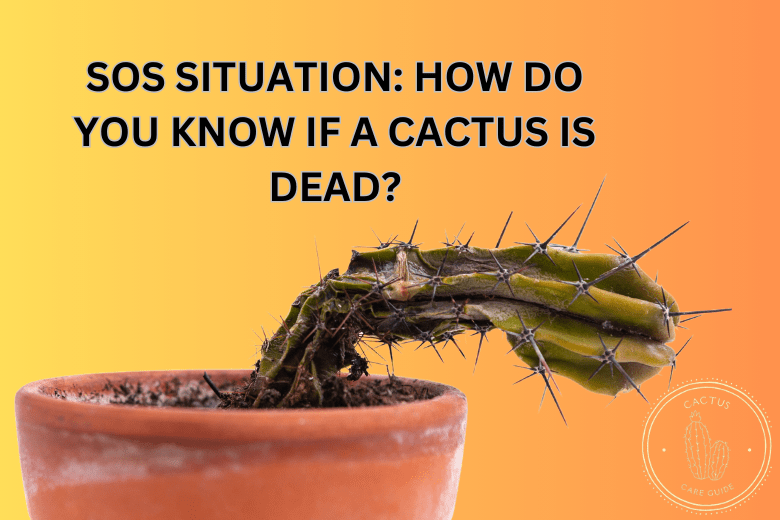When it comes to cacti, these resilient plants often evoke images of the arid desert, showcasing their tenacity in survival. But what happens when your spiky friend begins to lose its vibrancy? Picturesque as they may seem, determining the vitality of a cactus can pose a perplexing challenge for many plant enthusiasts. The question looms: how do you know if a cactus is dead? Here’s an exploration of the signs to watch for, helping you discern the fate of your prickly companion.
Recognizing the symptoms of distress in cacti is pivotal for their preservation. Armed with the right knowledge, you can potentially salvage a declining specimen. So, let’s dissect the signs that may indicate that a cactus is teetering on the brink of death.
Physical Indicators of Decline
Physical appearance is often the first indicator of a cactus’s health status. Cacti are typically characterized by their stiffness and spiky exteriors, a direct response to their adaptation in harsh conditions. However, observed changes in these physical traits can herald trouble.
One of the most evident signs of distress is a soft or mushy texture. Healthy cacti are firm, whereas a cactus that feels squishy may be suffering from overwatering, root rot, or disease. If the body of the cactus seems to sag or collapse under its own weight, it may be time to investigate further. Symptoms of excessive moisture can manifest in the form of dark, sunken spots, often culminating in a decay that is difficult to reverse.
In contrast, a cactus that has shriveled or appears unusually shrank can be signaling dehydration. This can occur during an extended period of neglect or insufficient watering. Look for cracked or shriveled skin, which indicates that the plant is expiring from lack of resources. Both extremes—excess moisture and insufficient hydration—underscore the essential balance that cacti necessitate.
Color is another vital clue. A cactus that loses its vibrant green hue and takes on a yellowish or brownish tint may be a sign of stress, possibly due to overexposure to sunlight or nutrient deficiencies. Conversely, dark, murky discolorations can indicate fungal invasions or rotting from the roots up. Examining the skin for changes in color can provide pivotal insights into its health.
Root Assessments and Pot Conditions
If external cues do not yield sufficient clarity regarding your cactus’s vitality, a deeper inspection may be warranted—assessing its roots and the pot conditions can offer an enlightening perspective.
To examine the roots, gently remove the cactus from its pot. A healthy root system is typically white or light tan and firm. Roots that appear dark, mushy or have an unpleasant odor signal rot, which often necessitates immediate intervention. In cases of root rot, it may be imperative to trim away the affected roots and repot the cactus in fresh, dry soil.
Additionally, examine the state of the potting medium. If the substrate is consistently soggy, it can suffocate the roots, fostering conditions that lead to decay. Cacti thrive in well-draining soil, and an overly dense or non-porous potting mix can jeopardize their longevity.
Environmental Influences: The External Factors
Beyond physical indicators, many external factors impact a cactus’s well-being. Humidity, temperature fluctuations, and light exposure are pivotal environmental considerations.
Cacti flourish in arid climates. When succumbing to excessive humidity or cool temperatures, signs of distress can surface. An optimal environment mirrors their natural habitat—dry and warm. Ensure your cactus is not ensconced in dampness or subjected to a frigid draft. If the location causes concern, consider relocating the plant to a sunnier, warmer area.
Moreover, lighting conditions significantly influence growth and health. An underexposed cactus may demonstrate etiolation—a phenomenon where the plant stretches, elongating its body in search of sunlight. Conversely, an overabundance of sunlight can scorch the cactus, leading to unsightly spots or a spongy texture. Adjusting the plant’s positioning can often remedy lighting issues.
Interventions and Recovery Strategies
Upon identifying the signs of decline, it’s essential to formulate a recovery strategy. Interventions will vary based on the specific issues discerned.
If water loss is suspected, moderate hydration practices can be applied. Cacti should be watered sparingly; thorough soaking followed by complete drying is critical. This mimics natural rainfall patterns and fosters optimal growth.
For those exhibiting rot symptoms, surgical intervention might be needed. Pruning away decayed areas, along with prompt repotting in fresh, well-draining soil, increases the likelihood of recovery. Utilizing sterile tools during this process minimizes the risk of further pathogens infiltrating the plant.
In conclusion, knowing how to interpret the signs that indicate whether a cactus is dead or alive can be a valuable skill for any cactus owner. Through careful observation and attentive management, many challenges associated with cactus care can be effectively navigated. While it may seem overwhelming at first, understanding these cues will undoubtedly enhance your ability to cultivate and preserve these fascinating plants for years to come.





Leave a Comment